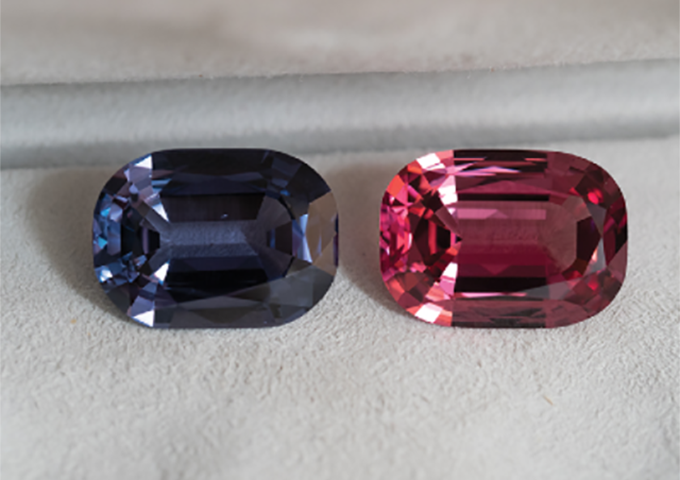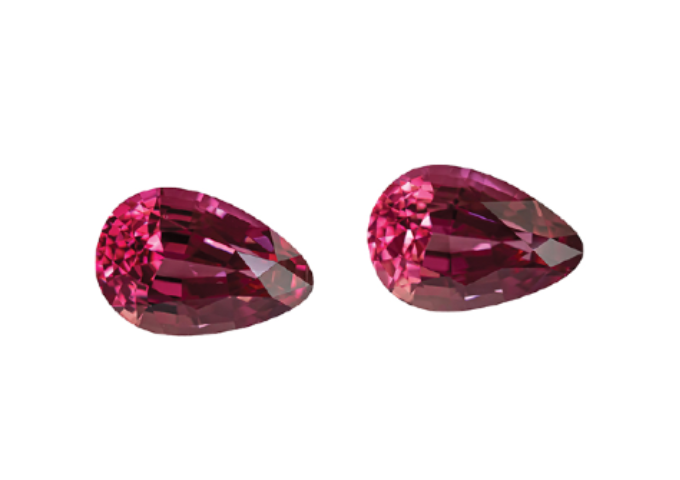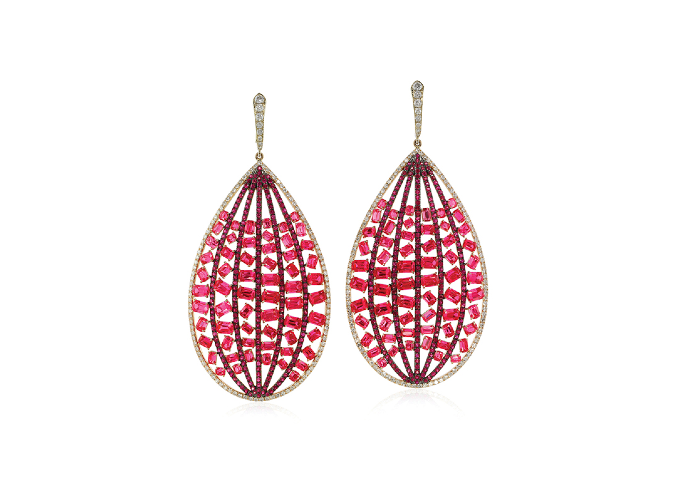With colour and vibrance to rival more established counterparts, spinel is rising in prominence in gem and jewellery circles. Once mistaken for other gemstones, it is coming into its own as the trade increasingly appreciates its range and versatility.
Long underestimated, spinel is finally taking its rightful place among the greats in the coloured gemstone world. In the last few years, it has been enchanting the trade and the public alike with its wondrous colours and versatility.
Remarkably, spinel had been hiding in plain sight for years, often mistaken for its more prominent counterparts. Royalty over the centuries displayed a fondness for the stone, which occupied pride of place in many a resplendent crown. The Black Prince’s Ruby, an uncut 170-carat red spinel, adorns the Imperial State Crown of the British royal family. Spinels likewise sparkle in the jewels of the Tsars of Russia and the Mahajarahs of India.
In more recent times, spinel has gained favour in its own right. It ascended to the birthstone ranks in 2016, sharing August billing with peridot. The gemstone is likewise increasingly being showcased in the high jewellery collections of luxury brands such as Cartier and Van Cleef & Arpels. One of the highlights of Bulgari’s Magnifica 2021 high jewellery collection is the Imperial Spinel necklace, which features a 131.21-carat spinel, the world’s fourth largest, surrounded by emerald beads and diamonds.
All this has elevated spinel in the public eye, noted Tais Farkhodova, marketing manager of Pamir Gems. “Famous jewellery houses have been using spinel in their collections, giving the stone a fashionable and luxurious image,” she remarked.
Colourful horizons
Colour is spinel’s star quality. Its wide range of colours enables it to fit various design palettes and accommodate most requirements. Spinel meets market demand for fine pinks and reds, adds crisp selections to the ever-popular blue stone category, and offers dazzling options for oranges, lavenders and greys.
“The range of colours in spinel’s palette is astounding. Moreover, spinels can be very clean and clear, and come in small to bigger sizes, making them a delight to work with,” said Farkhodova.
Market preferences for spinel colours are largely influenced by design, fashion and art trends, she pointed out. Of late, perhaps in response to the gloomy global sentiment, people have been partial to bright, happy, saturated colours.
Josh Saltzman of gemstone specialist Nomad’s agrees. In his experience, spinels in bright colours are always in favour, such as reds and pinks. Blues, particularly cobalts from Vietnam, and lavenders are much sought after as well. Grey spinels have surged in popularity in the last few years, he added.
“Colour is the main factor most clients consider when selecting spinels. The stones sell quickly when cut and polished well,” he disclosed. “Fine high-end red and pink stones are hard to find in the market in general. Spinel provides this with bright open colours in larger sizes, which helps drive its popularity. On top of this, it is uncommon for spinel to be treated, so the stones are available without the large amounts of treatments that most rubies and sapphires undergo.”
For Hamed Kazemini, co-founder and partner of Ruby Roje, spinel’s brilliance is second to none. “It is a fascinating stone that really shines. The rough allows the stones to be cut very well, creating a balance and symmetry that is very pleasing to the eye,” he said.
Demand patterns
Spinel has indeed been coming into its own these last few years, with coloured gemstone dealers reporting a substantial spike in interest.
Singapore, Europe and the US are Pamir Gems' main markets for the gemstone.
Nomad’s entertains requests for spinels in all colours, cuts and sizes across its markets in Asia, Europe and the Americas. Its clients range from collectors and manufacturers to small jewellers and larger brands.
“Spinel was undervalued and ignored for such a long time that its rise in popularity in the past 13 or so years has really piqued the interest of gem and jewellery lovers. Many of the famous big rubies were actually spinel. This helps us explain to people new to the stone why it is such a unique gem,” Saltzman remarked.
Fine spinel – clean, well cut and with a nice open colour – moved well across markets in pre-Covid times, he noted. Despite the general downturn brought about by the pandemic, demand has been consistent for nice spinel in reds, pinks, lavender, blue, cobalt blue and grey.
Leading spinel expert Vladyslav Yavorskyy shares this observation. Founder of gemstone specialist Yavorskyy and fine jewellery company Ivy New York, he has been collecting the stone for over 25 years. “In the last two years especially, spinel has become the hottest item all over the world. Nowadays, gemstone dealers get the most calls for Paraiba tourmaline and Mahenge red spinels,” he noted.
Yavorskyy's bestsellers this year though have been lavender spinels, which he said are rarer still than the lucrative fine reds. Demand for grey spinels has also skyrocketed of late, he added.
Kazemini said, “Twenty years ago, spinel was the stone nobody loved or even noticed. (Yavorskyy) took the contrarian view and started collecting the gem. It took time for the market to catch on, but today, spinel is the stone that everybody wants and needs.”
Colour, cut and clarity are the main determinants of a spinel’s appeal, unlike other gemstones such as emeralds, rubies and sapphires whose provenance can dictate their value and market demand.
“Customers are mainly concerned with the quality of the spinel, not its origin. This is beneficial to the trade as the focus is on the stone, not where a certificate says it is from,” said Saltzman.
Cobalt spinels are the exception to this rule. “Cobalt blue spinels from Vietnam are highly sought after because of their vivid colour and rarity. Stones over 1 carat are difficult to find,” he explained. “Cobalt spinels from Sri Lanka meanwhile tend to be darker and more saturated in colour, but their finest vivid blues are also in high demand due to their rarity.”
Vivid red spinels from Man Sin in Myanmar, often called Jedi spinel, are popular too, Saltzman continued.
The Mahenge mine in Tanzania produces vibrant pinks and deep reds. Mogok in Myanmar yields red spinels in many hues, saturations and shades; those from the Man Sin mine emit a neon-like glow. Mines in the Pamir mountains of Tajikistan gave the world beautiful specimens of red and pink spinel.
Yavorskyy noted that for spinel under 5 carats, the best Mahenge stones are pinkish-red while Mogok delivers top-saturation goods but seldom yields vivid reds in bigger sizes.
Business considerations
The main challenge facing the spinel trade is the limited supply of fine material, according to Saltzman. Spinel has never come to the market in large quantities. Big finds in Mahenge in 2007 resulted in a larger amount of fine material for a certain period of time. Supply has been tight since.
“The restrictions of the past year have exacerbated the situation. There seems to have been limited mining and, given logistical and travel challenges, some difficulty in bringing material to the market,” Saltzman explained.
The scarcity of fine rough material and ever-growing demand for spinel in the last few years have caused the value of the stones to appreciate.
Saltzman remarked that gemstone manufacturers’ main concern with spinel these days is replacing what has been sold.
Owners of fine spinel now tend to hold on to their stones as they fear they will not be able to replace it at the right price, said Kazemini.
“Exceptionally fine spinels are hard to find in the market at reasonable prices. Once you let go of a stone, it would be extremely difficult to find similar ones at the same price,” Yavorskyy added.
As a pioneer in the spinel trade, he attests to the soaring value of the stone. Fine spinel under 2 carats may cost US$200 to US$1,000 per carat, but bigger stones fetch much higher sums. Gem-quality large- size spinel can now command prices upwards of US$100,000, a far cry from the fine material that cost US$3 to US$5 per stone a couple of decades ago. In 1994, spinels in Sri Lanka were selling for around US$3 per carat, he recalled. Some 25 years later, prices had risen to around U$3,000 to US$8,000 per carat.
In fact, back in 2017, Yavorskyy acquired a loupe- clean, 6-carat cushion-shaped red spinel from Mogok at US$126,000, setting a record-high per-carat price for spinel.
“In the span of 25 years, the price of spinel never once dropped. It has consistently gone up and continues to do so,” he revealed. “Meanwhile, an aquamarine I bought around 25 years ago would likely fetch the same price today.”
Supply challenges notwithstanding, the spinel trade will continue to shine for the foreseeable future. “If more fine material comes to the market, spinel has the potential to win over a wider swath of the general public and increase its popularity and reach even more,” Saltzman remarked.


















